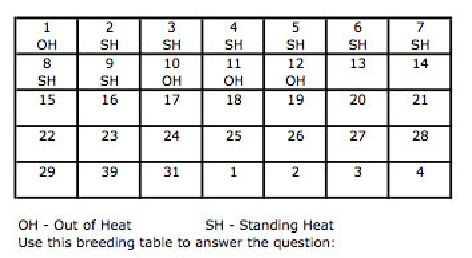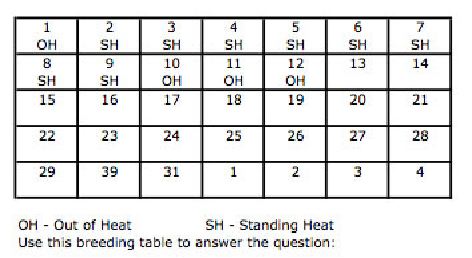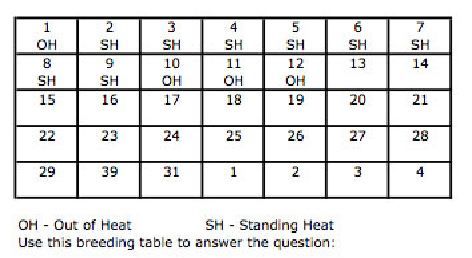Multiple Choice
Identify the
choice that best completes the statement or answers the question.
|
|
|
1.
|
In performance horses besides adequate water and salt the most important dietary
factor is _______.
a. | energy | b. | corn | c. | protein | d. | fiber |
|
|
|
2.
|
At least 50% of the horses diet should be_________.
a. | concentrates | b. | fats | c. | roughage | d. | proteins |
|
|
|
3.
|
A dry winter coat is good to ________ to maintain comfort.
|
|
|
4.
|
A horse is classified digestively as a _________.
a. | ruminant | b. | non-ruminant | c. | carnivore | d. | omnivore |
|
|
|
5.
|
A mature male horse will have ________ teeth.
|
|
|
6.
|
Mastication is defined as: ________
a. | chewing | b. | breathing | c. | expelling gas | d. | rumination |
|
|
|
7.
|
_________ is a simple muscular tube that takes food from the mouth to the
stomach.
a. | windpipe | c. | throat | b. | esophagus | d. | sphincter valve |
|
|
|
8.
|
The colon or large intestine will hold _______ quarts.
|
|
|
9.
|
Decreases in food intake or the horse not eating is the first sign of
________.
a. | protein deficient | c. | water deficient | b. | far deficient | d. | fiber deficient |
|
|
|
10.
|
Sugars and starches make up what?
a. | fats | c. | proteins | b. | lipids | d. | carbohydrates |
|
|
|
11.
|
Fats produce _______ times more energy per pound than carbohydrates.
|
|
|
12.
|
In general, it takes about ______ pounds of green forage to provide the same
amount of nutrients found in one pound of dried forage.
|
|
|
13.
|
Ohio is deficient in the trace minerals:
a. | Iodine, Copper, Zinc | c. | Zinc, Copper | b. | selenium, Copper | d. | Iodine Selenium |
|
|
|
14.
|
The cost of a ton of hay is $85.00. If a bail weighs 75 pounds, how many bails
will you get if you buy $255.00 worth of hay?
|
|
|
15.
|
________ has become the number one feed fed to horses due economics.
a. | oats | b. | barley | c. | wheat bran | d. | corn |
|
|
|
16.
|
___________ can be defined as a deficiency of red blood cells.
a. | arterial embolism | c. | anemia | b. | vascular disease | d. | hemolysis |
|
|
|
17.
|
_________ is the name given to arthritis of the hock joint.
a. | splints | c. | bone spavin or jack spavin | b. | hock
rot | d. | joint ill
|
|
|
|
18.
|
The foreign carry ______ percent of the weight of the horse.
|
|
|
19.
|
_______ is characterized by a high fever, loss of appetite, and swelling of the
lymph nodes.
a. | Rhinitis | b. | Sinusitis | c. | Strangles | d. | S.A.P. |
|
|
|
20.
|
_________ is due to an increase in fluid pressure in the eyeball.
a. | retinal tare | c. | chorioretinitis | b. | night blindness | d. | glaucoma |
|
|
|
21.
|
The mare in question should have ovulated on what date? 
|
|
|
22.
|
If the mare was bred on the 6th when should she be palpated to diagnose
pregnancy? 
|
|
|
23.
|
When should the mare return to standing heat? 
|
|
|
24.
|
The best day to A.I. the above mare is? 
|
|
|
25.
|
Sperm live for _____ hours in the mare’s reproductive tract.
a. | 96-120 | b. | 48-72 | c. | 24-48 | d. | 12-36 |
|
|
|
26.
|
______ is a female horse under 2 years of age.
a. | filly | b. | mare | c. | gelding | d. | colt |
|
|
|
27.
|
Estrous cycle length is how long in the mare?
a. | 12 days | b. | 21 days | c. | 28 days | d. | 36
days |
|
|
|
28.
|
Another name for foaling is ______.
a. | parturition | b. | gestation | c. | castration | d. | mastication |
|
|
|
29.
|
Oxytocin causes:
a. | smooth muscle contractions | c. | muscle growth | b. | long bone
growth | d. | cartilage
growth |
|
|
|
30.
|
Progesterone is produced by:
a. | pituitary gland | c. | corpora lutea | b. | follicle | d. | granulosa cells |
|
|
|
31.
|
________ is the most heritable trait in horses.
a. | fertility | c. | muscling | b. | pulling power | d. | length of
stride |
|
|
|
32.
|
_____ is the lest heritable trait in horses.
a. | fertility | c. | muscling | b. | pulling power | d. | length of
stride |
|
|
|
33.
|
Which of the following would be homozygous recessive?
|
|
|
34.
|
Which of the following would carry the recessive trait, yet show the dominant
trait?
|
|
|
35.
|
When breeding a HH stallion to a hh mare the offspring will be?
|
|
|
36.
|
When breeding a HH stallion to a hh mare how many offspring will exhibit the
recessive trait?
|
|
|
37.
|
Justin Morgan developed the _____ breed.
a. | Paint | c. | Morgan | b. | Quarter Horse | d. | Halflinger |
|
|
|
38.
|
______ are bred for speed.
a. | Welsh | b. | Percheron | c. | Saddlebred | d. | Thoroughbred |
|
|
|
39.
|
Colorful spotting is the most prominent characteristic of what breed?
a. | Appaloosa | c. | Paint | b. | Quarter Horse | d. | Percheron |
|
|
|
40.
|
________ is known as a color breed.
a. | Quarter Horse | c. | Palomino | b. | Arabian | d. | Percheron |
|
|
|
41.
|
________ would be breeding a dam to her grandget.
a. | crossbreeding | c. | outcrossing | b. | pure breeding | d. | line breeding |
|
|
|
42.
|
Parrot mouth is a ______ trait.
a. | recessive | b. | dominant | c. | sex linked | d. | epistasis |
|
|
|
43.
|
Umbilical hernia is a _______ trait.
a. | recessive | b. | dominant | c. | sex linked | d. | epistasis |
|
|
|
44.
|
If a mare were CC for cyptorchid (homozygous dominant) then all of her male
offspring would be?
a. | carriers for cyptorchid | b. | have cyptorchid | c. | have no chance of
cyptorchid or in passing it to an offspring | d. | none of these are
correct |
|
|
|
45.
|
Horses have _______ pairs of chromosomes.
|
|
|
46.
|
A ________ is a written ancestry of a horse.
a. | breed paper | c. | generation sheet | b. | breeding sheet | d. | pedigree |
|
|
|
47.
|
A ______ is a male breeding horse.
a. | stallion | b. | mare | c. | gelding | d. | filly |
|
|
|
48.
|
Hay should be free of:
a. | mold | c. | dust | b. | weeds | d. | all of these are
correct |
|
|
|
49.
|
______ are nitrogen-fixating plants.
a. | grasses | b. | broad leaves | c. | legumes | d. | weeds |
|
|
|
50.
|
______ is not needed by the horse because sufficient amounts are synthesized in
the liver.
a. | B vitamins | b. | Vitamin E | c. | Vitamin K | d. | Vitamin
C |
|